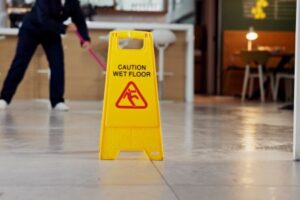Wet Floor Signs and How They Affect Premises Liability Claims

When in a building, you might see a “Wet Floor” sign in a hallway or near a restroom. These signs are indicators that you should walk extra carefully.
One of the most common hazards in commercial properties is a wet floor. While many businesses use “Wet Floor” signs to warn customers, it’s important to know that the law does not specifically require that warning method. Property owners can meet their duty to warn in various ways, such as placing orange cones, blocking off the area with tape, or even having an employee stand near the wet surface to alert people.
Still, many businesses do use wet floor signs. These signs play a key role in premises liability cases because they relate directly to a property owner’s duty to warn visitors of dangerous conditions. When a floor is wet from cleaning, spills, or weather-related moisture, property owners or managers are expected to either clean the hazard promptly or clearly warn guests, often by placing a visible wet floor sign.
However, a wet floor sign does not automatically protect a business from liability. While it can be a strong defense, claim success often depends on how visible and reasonable the warning was, and whether the property owner took other steps to make the area safe. Here are some things you should know if you are a victim of a slip and fall accident.
How Wet Floor Signs Impact Liability
- Sign present and properly placed. If a wet floor sign was clearly visible and placed near the hazard, the property owner may argue that they fulfilled their duty to warn, which can reduce or even eliminate their liability. The injured person may then need to prove that the warning was inadequate, poorly placed, or not visible enough.
- No sign or poor warning. If no warning sign was used, or it was placed in a way that did not reasonably alert people, this may strengthen the injured party’s claim by showing negligence in warning about a known danger.
- Comparative negligence. Even if a sign was posted, the injured person may still have a claim if the sign was not easy to see or if the conditions were unusually hazardous. However, the presence of a sign can affect comparative fault, reducing compensation if the injured person is found partially responsible for ignoring a clear warning.
Can I Sue?
You can sue for a slip and fall injury, but the burden of proof is on you. You need to prove all the following:
- The establishment was aware of the wet floor or should have been aware of the wet floor.
- The establishment failed to warn you about the wet floor.
- You slipped on the wet floor and injured yourself.
Contact a New Jersey Personal Injury Lawyer Today
Slips and falls can lead to serious injuries. Whether or not you were warned, the business may be liable to some degree.
A Morristown premises liability attorney from The Law Offices of Michael P. Burakoff can help you file a claim if you suffered injuries due to an unsafe condition. To schedule a consultation, call (973) 455-1567 or fill out the online form.
Source:
enjuris.com/premises-liability/wet-floor-sign/

